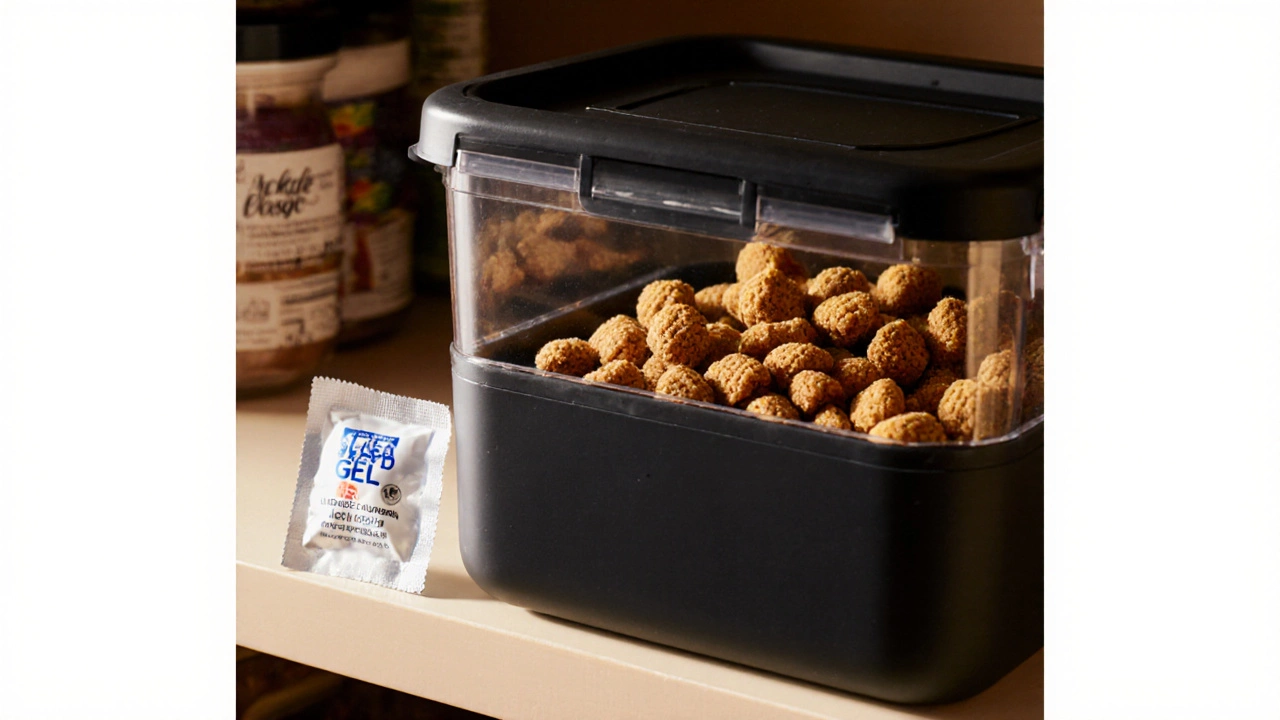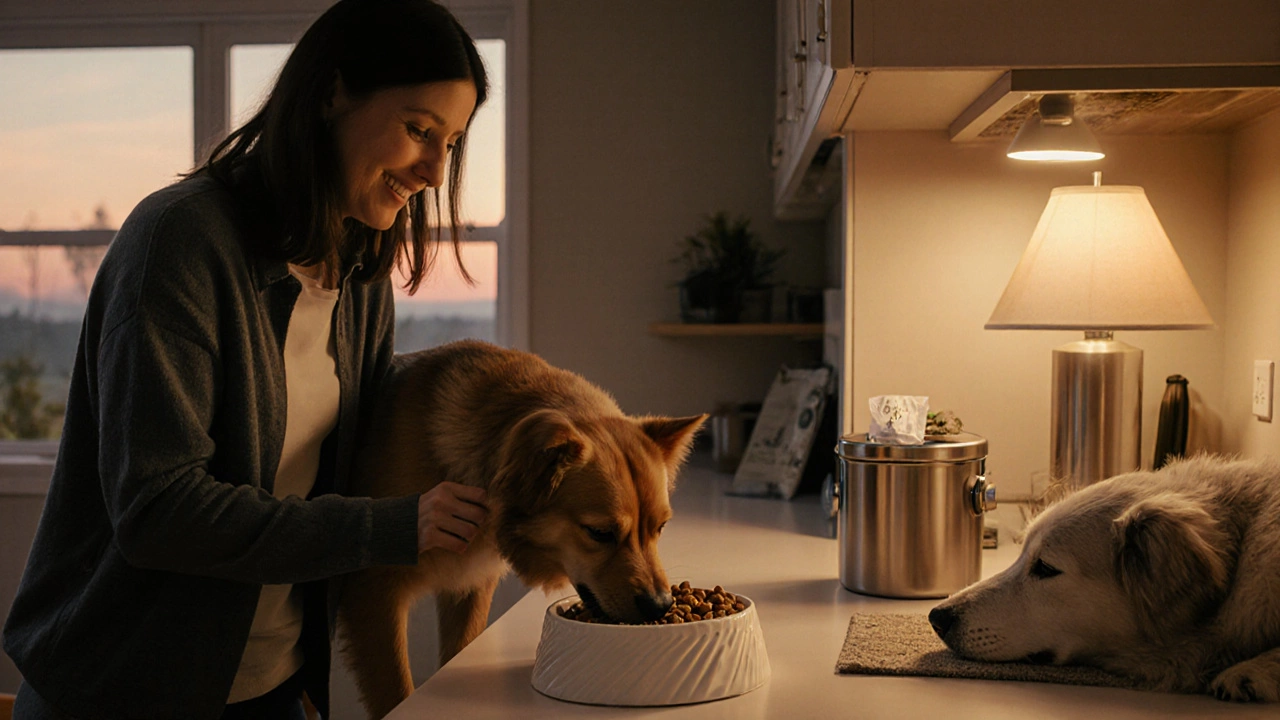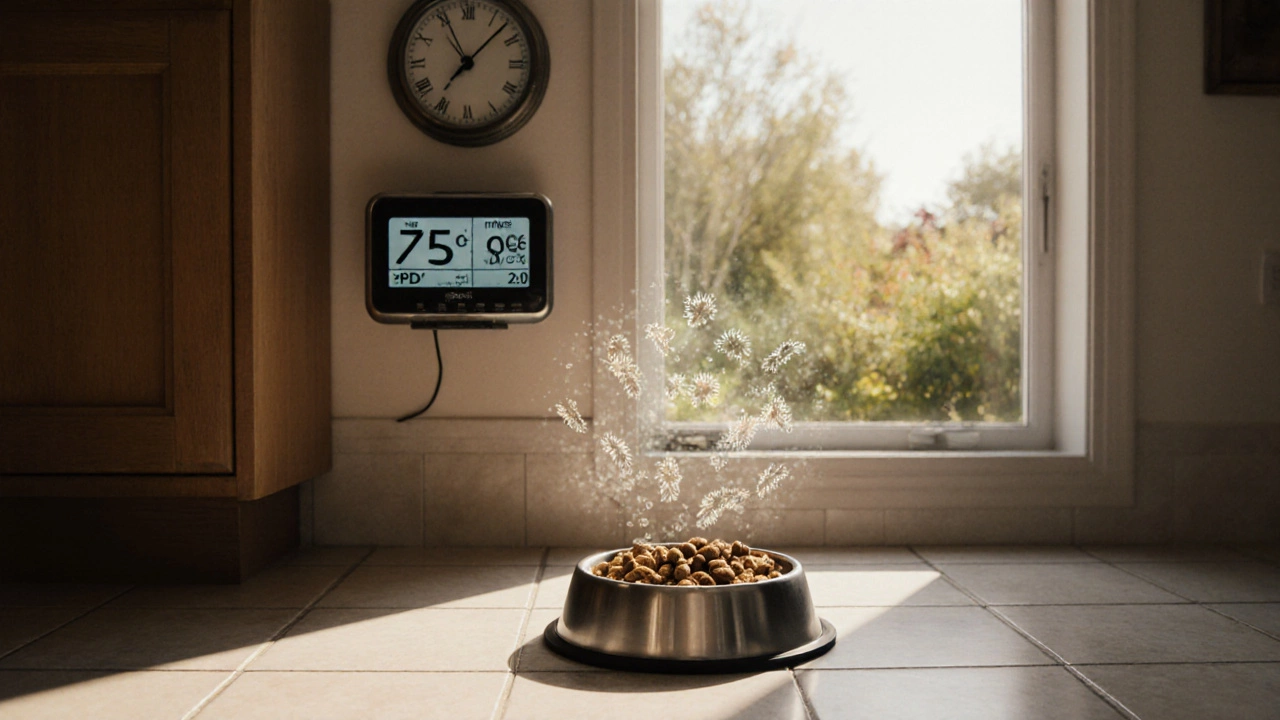Dry Dog Food Safety Calculator
Safe Duration Calculator
Calculate how long dry dog food can safely be left out based on temperature and humidity levels.
Enter temperature and humidity to see safe food duration.
Important note: This calculator uses guidelines from veterinary studies to determine safe food exposure times. Always check for signs of spoilage before feeding.
When it comes to feeding our four‑legged friends, the biggest question many owners ask is whether they can just toss a bowl of dry kibble on the floor and walk away. The short answer is: it depends on what’s happening to that kibble while you’re out. In this guide we’ll break down the science behind dry dog food safety, show you how temperature, humidity and time interact, and give you a clear plan to keep your pup healthy without turning mealtime into a guessing game.
Dry dog food is a nutritionally balanced kibble that provides most of a dog’s daily calories, protein, fats and essential vitamins in a low‑moisture, shelf‑stable form. Because it contains less than 10% moisture, it can sit out longer than wet food, but it isn’t immune to spoilage.
Why Time Matters: The biology of kibble
Even though dry kibble looks like a hard, lifeless brick, it’s still a living food matrix. Once the bag is opened, three main processes start to degrade its quality:
- Bacterial contamination: Air‑borne bacteria such as Salmonella or Clostridium perfringens can settle on the surface and multiply if the environment is warm and moist.
- Oxidation: Fats in the kibble oxidize when exposed to oxygen, leading to rancidity, off‑flavors, and loss of essential fatty acids.
- Moisture absorption: Humidity pulls water into the kibble, creating pockets where microbes thrive and where the kibble becomes soft and unpalatable.
All three processes accelerate after the food passes the “safe window” set by the manufacturer’s use‑by or best‑by date. Knowing the window helps you decide how long you can leave the bowl unattended.
Temperature and humidity: The hidden variables
Most pet owners focus on the clock, but the environment is equally crucial. Here’s a quick rule of thumb:
- Below 68°F (20°C) and under 50% relative humidity, dry kibble stays stable for up to 8 hours.
- Between 68‑78°F (20‑26°C) with 50‑70% humidity, the safe period drops to 4‑6 hours.
- Above 78°F (26°C) or humidity above 70%, you should limit exposure to 2 hours or less.
These thresholds come from studies by the American Veterinary Medical Association (AVMA) and the Food and Drug Administration (FDA) on pet food storage. When the temperature climbs, bacterial growth rates double roughly every 10 °F, a phenomenon called the Q10 effect.
What the experts say
Veterinary nutritionists agree that the risk of foodborne illness in dogs from dry kibble is low compared to raw or wet food, but it’s not zero. Dr. Emily Carter, a board‑certified veterinary nutritionist, notes, “A dog that eats kibble left out for a full day in a warm kitchen can develop mild gastroenteritis, especially if the dog has a sensitive stomach or an immature immune system.”
The National Research Council’s Pet Food Nutrient Profiles also recommend that owners store kibble in a cool, dry place and discard any food that looks clumped, smells sour, or has changed color.
Practical storage tips to extend freshness
Below are everyday actions that dramatically improve kibble’s shelf life and keep it safe for longer feeding periods:
- Use an airtight container made of BPA‑free plastic or stainless steel to limit oxygen exposure.
- Place the container inside a pantry or cabinet away from ovens, dishwashers, or sunlight.
- Consider adding a food‑grade desiccant packet (silica gel) to absorb excess moisture.
- Rotate stock: use older bags first and keep a small “freshness window” of about two weeks for new purchases.
- If you feed multiple dogs, keep each dog’s bowl clean and empty it after each meal to prevent cross‑contamination.
These steps align with Pet food regulations from the USDA and the FDA, which require manufacturers to provide clear storage instructions on the packaging.
Comparison table: Factors affecting dry dog food safety
| Factor | Effect on Food | Recommended Action |
|---|---|---|
| Temperature | Speeds up bacterial growth and oxidation | Keep feeding area below 68°F (20°C) when possible |
| Humidity | Promotes moisture absorption, leading to softer kibble | Store kibble in airtight containers; use desiccants |
| Exposure Time | Longer exposure increases risk of spoilage | Limit bowl exposure to 4‑6 hours in moderate climates |
| Packaging Integrity | Damaged bags allow oxygen and pests inside | Inspect bags for tears; transfer to secondary containers |
| Ingredient Quality | Higher fat content can oxidize faster | Choose kibble with natural antioxidants; rotate stock |

When to toss the kibble
Even the best storage won’t save food that’s clearly gone bad. Look for these red flags:
- Clumping or sticky texture.
- Rancid or sour smell.
- Visible mold or discoloration.
- Unusual taste (if you’re willing to test a tiny piece).
If any of these appear, discard the batch immediately. Feeding spoiled kibble can lead to vomiting, diarrhea, or more serious conditions like Clostridial enteritis.
Designing a safe feeding schedule
Here’s a simple workflow that works for most dog owners:
- Prepare a fresh bowl of kibble each feeding time (morning and evening are common).
- Set a timer on your phone for the maximum safe exposure based on your home’s climate (e.g., 4 hours).
- When the timer goes off, remove any leftover kibble and store it in the airtight container.
- Clean the bowl with hot, soapy water or a dishwasher cycle.
- Track any digestive upset in a pet health journal; if symptoms repeat, shorten exposure time.
This routine mirrors recommendations from the American Society for the Prevention of Cruelty to Animals (ASPCA) and helps you stay consistent without second‑guessing.
Special cases: Puppies, senior dogs, and health‑compromised pets
Young puppies and older dogs often have weaker immune systems. For them, err on the side of caution:
- Limit bowl exposure to no more than 2 hours, regardless of temperature.
- Consider using a slow‑feed bowl that forces the dog to eat slower, reducing leftovers.
- If your dog is diabetic, overweight, or has food allergies, stick to exact portion sizes and remove leftovers promptly.
Veterinarians frequently advise these owners to keep a separate “fresh‑only” bowl for high‑risk dogs, then discard any remnants after each meal.
Bottom line: Balance convenience with safety
Leaving dry dog food out all day isn’t a hard‑no‑no, but it’s a risk that scales with heat, humidity, and how long you leave it. By controlling the environment, using proper storage containers, and watching for signs of spoilage, you can safely let your dog graze for a few hours without jeopardizing health.
Remember, the goal isn’t to lock your dog into a strict schedule, but to give you peace of mind that every bite is fresh, nutritious, and safe.

Can I leave dry kibble out for 12 hours on a cool night?
If the room stays below 68°F (20°C) and humidity stays under 50%, the kibble will likely remain safe for up to 8 hours. Beyond that, bacterial growth can start, so it’s best to discard leftovers after a full night.
What signs tell me my kibble has gone bad?
Look for clumping, a sour or rancid smell, discoloration, or visible mold. Any of these mean the kibble should be tossed.
Do I need a special container for dry dog food?
An airtight, BPA‑free container or a sturdy metal bin works well. The key is to keep oxygen and moisture out.
Is it safe for puppies to graze on kibble left out for a few hours?
Puppies have sensitive stomachs, so limit exposure to 2 hours in warm environments. Remove leftovers promptly.
How does humidity affect dry dog food?
High humidity accelerates moisture absorption, creating soft spots where bacteria thrive. Use desiccant packets and airtight containers to combat this.
